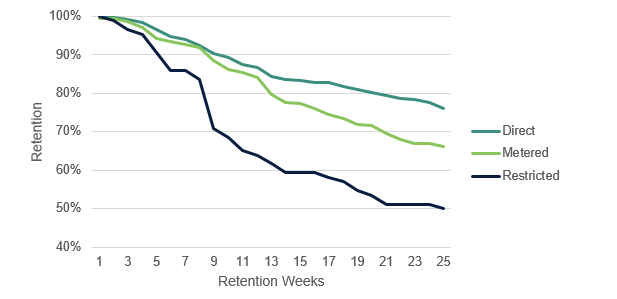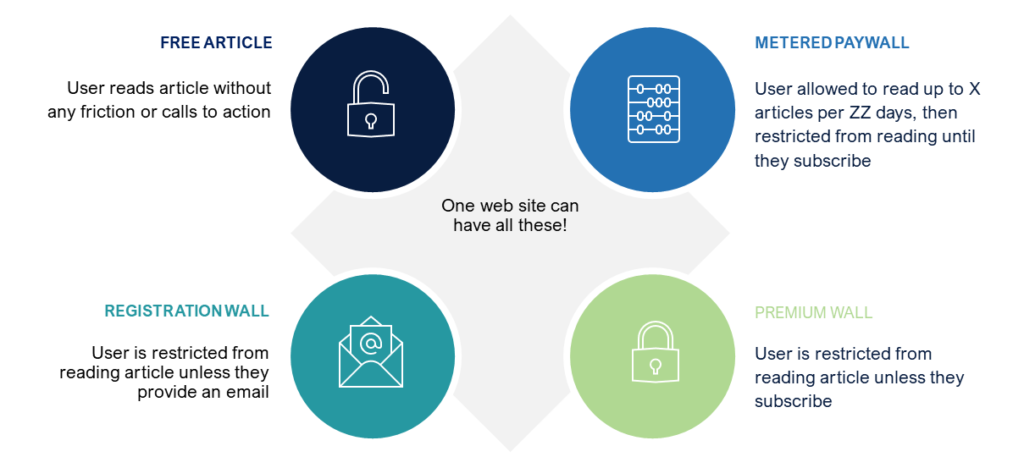SUMMARY: Combining the path to conversion and core score is one way to assess the value created by an article to the publisher from both subscription sales and retention.
INMA Satisfying Audiences Blog
February 16, 2022
By Matt Lindsay and Arvid Tchivzhel
A few months ago, Mather Economics authored this blog post on tests of algorithmically selecting articles for premium content (articles that are only available to paying readers). Today’s blog post extends some of the insights from our work on content economics introduced in that article. We would like to share how premium content fits into a broader paid content strategy and how certain types of content attract subscribers with different lifetime values.
To provide context for this analysis, it is important to understand the types of paid content. There are four categories from a paid content perspective: free, metered, registered, premium.
A publisher might use a variety of content types depending on its subscribers and their tendencies.
Content taxonomy (often labeled as sections) is also relevant to this discussion. Those sections include breaking news, local news, sports, business, and lifestyle topics. For this analysis, we evaluate performance metrics for subscribers who convert from different paid content subject categories as well as paid content types.
Metrics to align content and audience
When we analyze content consumption and subscriber conversion, there are a couple of metrics that we have found helpful. These metrics are calculated on a per-article basis and can be rolled up to subsection, section, and author levels.
Path to Conversion (PTC) is an attribution of paid subscription conversions to individual content items. To calculate the PTC for an article, we count how many times an article was read by a visitor in the 30 days prior to starting their subscription. PTC is also a key driver of Mather’s Paid Content Decision Engine.
Another metric is the Core Score, which is an index measuring readers in the publisher’s core audience. A high core score indicates that an article is engaging the publisher’s most important readers. This includes their subscribers, those who arrive directly to the site or from e-mailed links, those who are considered “in market,” and, most importantly, highly engaged visitors. These raw data are weighted and transformed into a composite score to measure when the core audience reads an article.
Combining the PTC and core score is one way to assess the value created by an article to the publisher from both subscription sales and retention. An extension of this analysis to include the customer lifetime value of subscribers from content items yields further insights into the economic value of content.
Not all PTCs are created equal
Patrick Tornabene at Newsday Media Group recently shared findings in this area. Tornabene and his team have found people who subscribed for specific topics have different retention patterns. “Health and food retain well, high school sports do not,” he noted.
These findings are consistent with Mather’s analysis of content in other markets. Tornabene made the point: “Not all PTCs are equal. Retention is a big differentiator, and core is where people are retaining better.”
The key takeaway from this insight is that the economic value of an article is not only how well it attracts and converts subscribers but how well those subscribers retain once they are converted.
This is particularly important when a publisher adopts an acquisition model like The Boston Globe’s, where a customer is offered a multi-month introductory subscription for a single low payment. This strategy is successful when the retention of subscribers moving from the introductory offer to the regular price is sufficiently high and the publisher ends up with more subscribers afterward than under a less aggressive acquisition offer.
Newsday has tested these acquisition offers and found them to be successful in their markets. Mather has identified factors important for evaluating subscription offers, and we have developed models to forecast trade-offs between introductory price, introductory term, full-price, and a renewal term. These models are being applied with other publishers to optimize acquisition offers in-market.
In addition to content, there is a difference in retention based on the paid content rule that converts a user. Subscribers acquired from Premium articles generally retain at a lower rate than subscribers from a metered article. The hypothesis is that the premium article subscriber is passionate about one particular item of content while a metered paywall subscriber has consumed more content prior to the conversion and is thus more engaged.
The best retention is observed with subscribers coming from a direct link, such as a “subscribe now” button on the home page. These customers are “voluntary” (to use a common marketing term), while metered and premium sites are “pressured” starts (new subscriptions where the sales attempt originates with the publisher).
However, as with price and other levers, there is significant upside in growing new starts through premium content, even with initially lower retention. The chart below shows retention by paid content category. Churn mitigation, new subscriber onboarding, and targeted renewal pricing can counter the lower retention rates from these subscribers.

Retention varies depending on paid content category.
Application and state of the industry
Applying these insights to optimize subscription revenue, Mather suggests using acquisition offers that are targeted based on a reader’s content consumption and the paid content type.
For instance, a reader who wants access to high school sports coverage in a premium article would receive a higher-priced subscription offer due to their greater retention risk. Conversely, a reader who is presented an offer on a metered cooking article would be offered a long-term introductory offer at a low price since they are much more likely to stay active after the initial term.
Since our early research with The Dallas Morning News on the intersection of audience and content analytics several years ago, newsrooms have adopted data science and metrics in many processes. For newsrooms, maximizing pageviews is no longer the primary objective. Maximizing long-term total revenue is now the goal for most publishers.
As digital subscribers reach their second and third year of tenure, newsrooms are again adapting performance metrics to include retention and subscriber engagement key performance indicators as they evaluate content performance. As a result of these trends, we expect newsroom processes and metrics to incorporate frameworks such as content lifetime value to optimize long-term revenue management.


